Entrepreneurship: Theories, Enterprise Analysis, and Economic Impact
VerifiedAdded on 2023/06/16
|10
|3133
|156
Report
AI Summary
This report provides a detailed analysis of entrepreneurship, beginning with an introduction to the core concepts and theories, including economic, psychological, sociological, anthropological, opportunity-based, and resource-based perspectives. It explores different types of enterprises, focusing on small and medium-sized enterprises (SMEs) and large enterprises, highlighting their roles in economic development and innovation, with examples like Flipkart. The report further examines the importance of entrepreneurship to individuals, organizations, and the economy, emphasizing job creation, innovation, improved living standards, and economic growth. It concludes by underscoring the essential role of entrepreneurship in fostering economic development and providing opportunities for personal and professional growth.

ENTREPRENEURSHIP IN
BUSINESS
BUSINESS
Paraphrase This Document
Need a fresh take? Get an instant paraphrase of this document with our AI Paraphraser
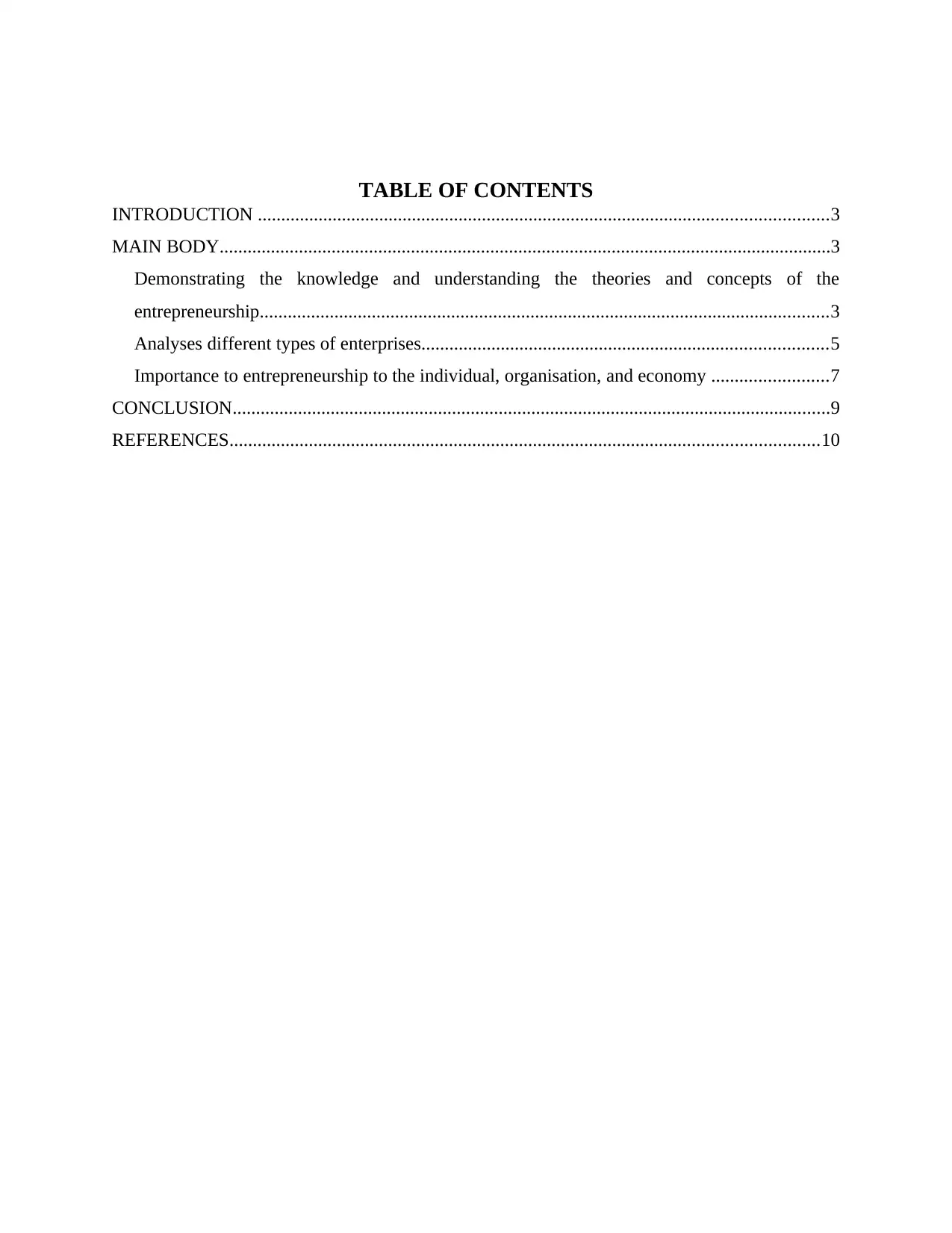
TABLE OF CONTENTS
INTRODUCTION ..........................................................................................................................3
MAIN BODY...................................................................................................................................3
Demonstrating the knowledge and understanding the theories and concepts of the
entrepreneurship..........................................................................................................................3
Analyses different types of enterprises.......................................................................................5
Importance to entrepreneurship to the individual, organisation, and economy .........................7
CONCLUSION................................................................................................................................9
REFERENCES..............................................................................................................................10
INTRODUCTION ..........................................................................................................................3
MAIN BODY...................................................................................................................................3
Demonstrating the knowledge and understanding the theories and concepts of the
entrepreneurship..........................................................................................................................3
Analyses different types of enterprises.......................................................................................5
Importance to entrepreneurship to the individual, organisation, and economy .........................7
CONCLUSION................................................................................................................................9
REFERENCES..............................................................................................................................10
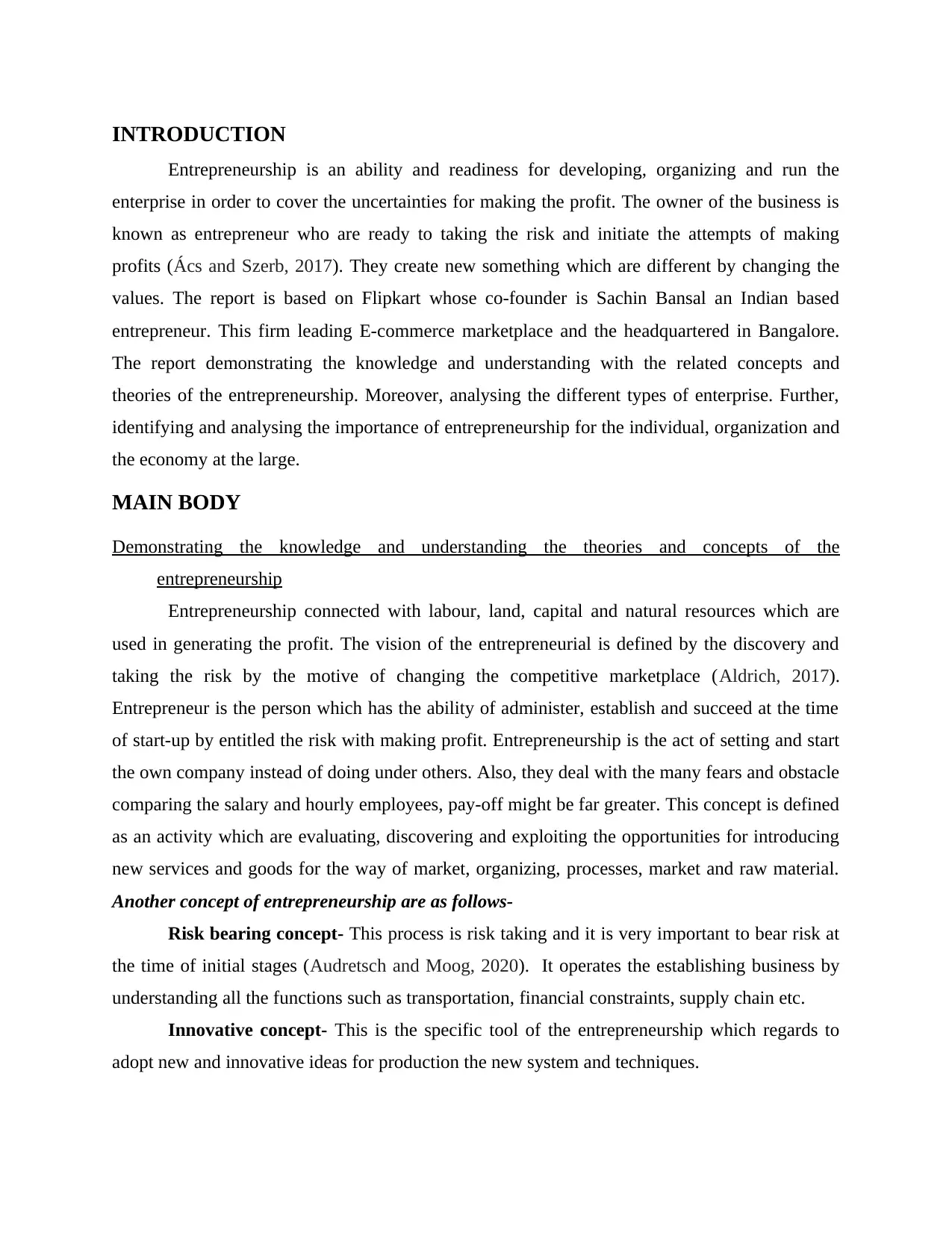
INTRODUCTION
Entrepreneurship is an ability and readiness for developing, organizing and run the
enterprise in order to cover the uncertainties for making the profit. The owner of the business is
known as entrepreneur who are ready to taking the risk and initiate the attempts of making
profits (Ács and Szerb, 2017). They create new something which are different by changing the
values. The report is based on Flipkart whose co-founder is Sachin Bansal an Indian based
entrepreneur. This firm leading E-commerce marketplace and the headquartered in Bangalore.
The report demonstrating the knowledge and understanding with the related concepts and
theories of the entrepreneurship. Moreover, analysing the different types of enterprise. Further,
identifying and analysing the importance of entrepreneurship for the individual, organization and
the economy at the large.
MAIN BODY
Demonstrating the knowledge and understanding the theories and concepts of the
entrepreneurship
Entrepreneurship connected with labour, land, capital and natural resources which are
used in generating the profit. The vision of the entrepreneurial is defined by the discovery and
taking the risk by the motive of changing the competitive marketplace (Aldrich, 2017).
Entrepreneur is the person which has the ability of administer, establish and succeed at the time
of start-up by entitled the risk with making profit. Entrepreneurship is the act of setting and start
the own company instead of doing under others. Also, they deal with the many fears and obstacle
comparing the salary and hourly employees, pay-off might be far greater. This concept is defined
as an activity which are evaluating, discovering and exploiting the opportunities for introducing
new services and goods for the way of market, organizing, processes, market and raw material.
Another concept of entrepreneurship are as follows-
Risk bearing concept- This process is risk taking and it is very important to bear risk at
the time of initial stages (Audretsch and Moog, 2020). It operates the establishing business by
understanding all the functions such as transportation, financial constraints, supply chain etc.
Innovative concept- This is the specific tool of the entrepreneurship which regards to
adopt new and innovative ideas for production the new system and techniques.
Entrepreneurship is an ability and readiness for developing, organizing and run the
enterprise in order to cover the uncertainties for making the profit. The owner of the business is
known as entrepreneur who are ready to taking the risk and initiate the attempts of making
profits (Ács and Szerb, 2017). They create new something which are different by changing the
values. The report is based on Flipkart whose co-founder is Sachin Bansal an Indian based
entrepreneur. This firm leading E-commerce marketplace and the headquartered in Bangalore.
The report demonstrating the knowledge and understanding with the related concepts and
theories of the entrepreneurship. Moreover, analysing the different types of enterprise. Further,
identifying and analysing the importance of entrepreneurship for the individual, organization and
the economy at the large.
MAIN BODY
Demonstrating the knowledge and understanding the theories and concepts of the
entrepreneurship
Entrepreneurship connected with labour, land, capital and natural resources which are
used in generating the profit. The vision of the entrepreneurial is defined by the discovery and
taking the risk by the motive of changing the competitive marketplace (Aldrich, 2017).
Entrepreneur is the person which has the ability of administer, establish and succeed at the time
of start-up by entitled the risk with making profit. Entrepreneurship is the act of setting and start
the own company instead of doing under others. Also, they deal with the many fears and obstacle
comparing the salary and hourly employees, pay-off might be far greater. This concept is defined
as an activity which are evaluating, discovering and exploiting the opportunities for introducing
new services and goods for the way of market, organizing, processes, market and raw material.
Another concept of entrepreneurship are as follows-
Risk bearing concept- This process is risk taking and it is very important to bear risk at
the time of initial stages (Audretsch and Moog, 2020). It operates the establishing business by
understanding all the functions such as transportation, financial constraints, supply chain etc.
Innovative concept- This is the specific tool of the entrepreneurship which regards to
adopt new and innovative ideas for production the new system and techniques.
⊘ This is a preview!⊘
Do you want full access?
Subscribe today to unlock all pages.

Trusted by 1+ million students worldwide
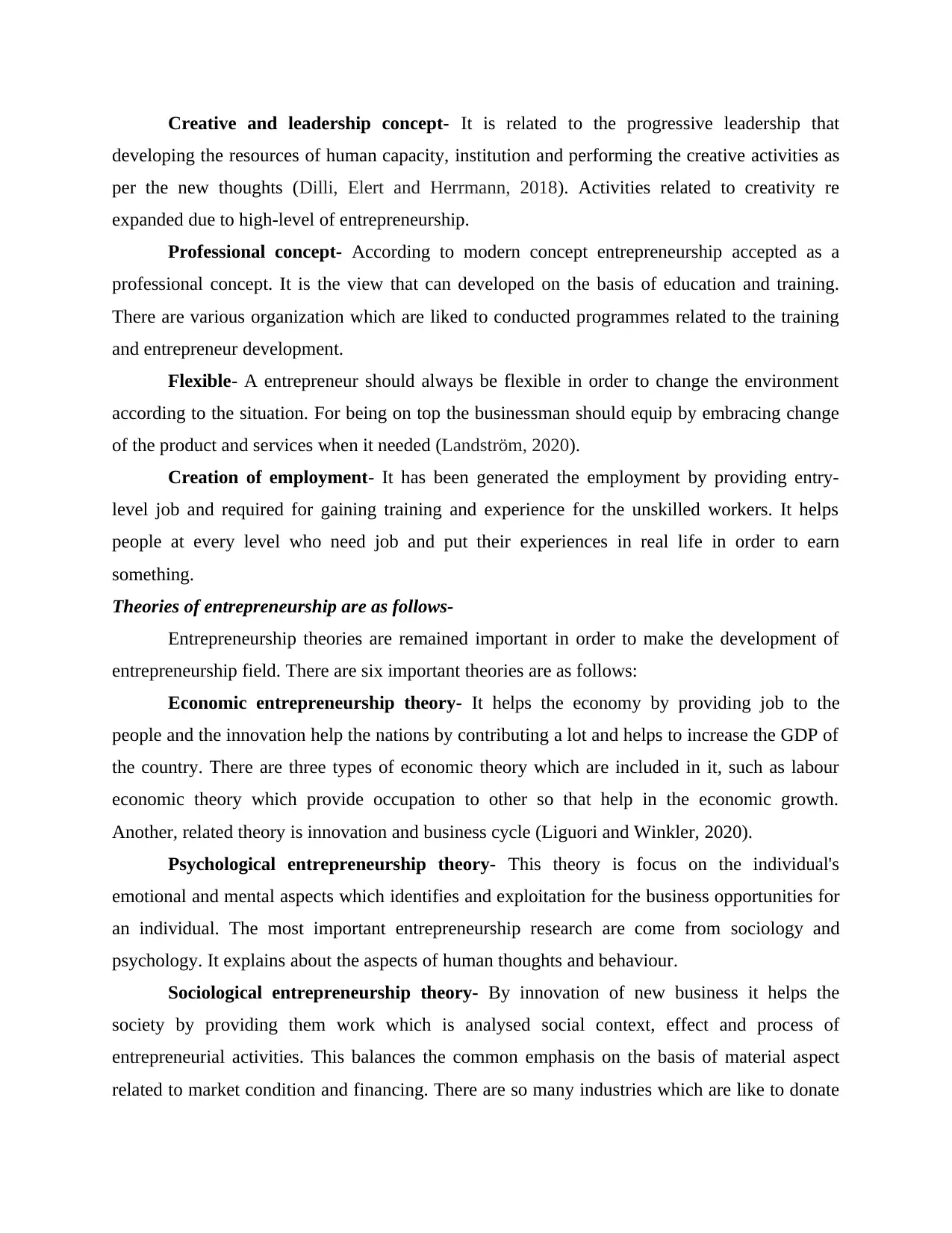
Creative and leadership concept- It is related to the progressive leadership that
developing the resources of human capacity, institution and performing the creative activities as
per the new thoughts (Dilli, Elert and Herrmann, 2018). Activities related to creativity re
expanded due to high-level of entrepreneurship.
Professional concept- According to modern concept entrepreneurship accepted as a
professional concept. It is the view that can developed on the basis of education and training.
There are various organization which are liked to conducted programmes related to the training
and entrepreneur development.
Flexible- A entrepreneur should always be flexible in order to change the environment
according to the situation. For being on top the businessman should equip by embracing change
of the product and services when it needed (Landström, 2020).
Creation of employment- It has been generated the employment by providing entry-
level job and required for gaining training and experience for the unskilled workers. It helps
people at every level who need job and put their experiences in real life in order to earn
something.
Theories of entrepreneurship are as follows-
Entrepreneurship theories are remained important in order to make the development of
entrepreneurship field. There are six important theories are as follows:
Economic entrepreneurship theory- It helps the economy by providing job to the
people and the innovation help the nations by contributing a lot and helps to increase the GDP of
the country. There are three types of economic theory which are included in it, such as labour
economic theory which provide occupation to other so that help in the economic growth.
Another, related theory is innovation and business cycle (Liguori and Winkler, 2020).
Psychological entrepreneurship theory- This theory is focus on the individual's
emotional and mental aspects which identifies and exploitation for the business opportunities for
an individual. The most important entrepreneurship research are come from sociology and
psychology. It explains about the aspects of human thoughts and behaviour.
Sociological entrepreneurship theory- By innovation of new business it helps the
society by providing them work which is analysed social context, effect and process of
entrepreneurial activities. This balances the common emphasis on the basis of material aspect
related to market condition and financing. There are so many industries which are like to donate
developing the resources of human capacity, institution and performing the creative activities as
per the new thoughts (Dilli, Elert and Herrmann, 2018). Activities related to creativity re
expanded due to high-level of entrepreneurship.
Professional concept- According to modern concept entrepreneurship accepted as a
professional concept. It is the view that can developed on the basis of education and training.
There are various organization which are liked to conducted programmes related to the training
and entrepreneur development.
Flexible- A entrepreneur should always be flexible in order to change the environment
according to the situation. For being on top the businessman should equip by embracing change
of the product and services when it needed (Landström, 2020).
Creation of employment- It has been generated the employment by providing entry-
level job and required for gaining training and experience for the unskilled workers. It helps
people at every level who need job and put their experiences in real life in order to earn
something.
Theories of entrepreneurship are as follows-
Entrepreneurship theories are remained important in order to make the development of
entrepreneurship field. There are six important theories are as follows:
Economic entrepreneurship theory- It helps the economy by providing job to the
people and the innovation help the nations by contributing a lot and helps to increase the GDP of
the country. There are three types of economic theory which are included in it, such as labour
economic theory which provide occupation to other so that help in the economic growth.
Another, related theory is innovation and business cycle (Liguori and Winkler, 2020).
Psychological entrepreneurship theory- This theory is focus on the individual's
emotional and mental aspects which identifies and exploitation for the business opportunities for
an individual. The most important entrepreneurship research are come from sociology and
psychology. It explains about the aspects of human thoughts and behaviour.
Sociological entrepreneurship theory- By innovation of new business it helps the
society by providing them work which is analysed social context, effect and process of
entrepreneurial activities. This balances the common emphasis on the basis of material aspect
related to market condition and financing. There are so many industries which are like to donate
Paraphrase This Document
Need a fresh take? Get an instant paraphrase of this document with our AI Paraphraser
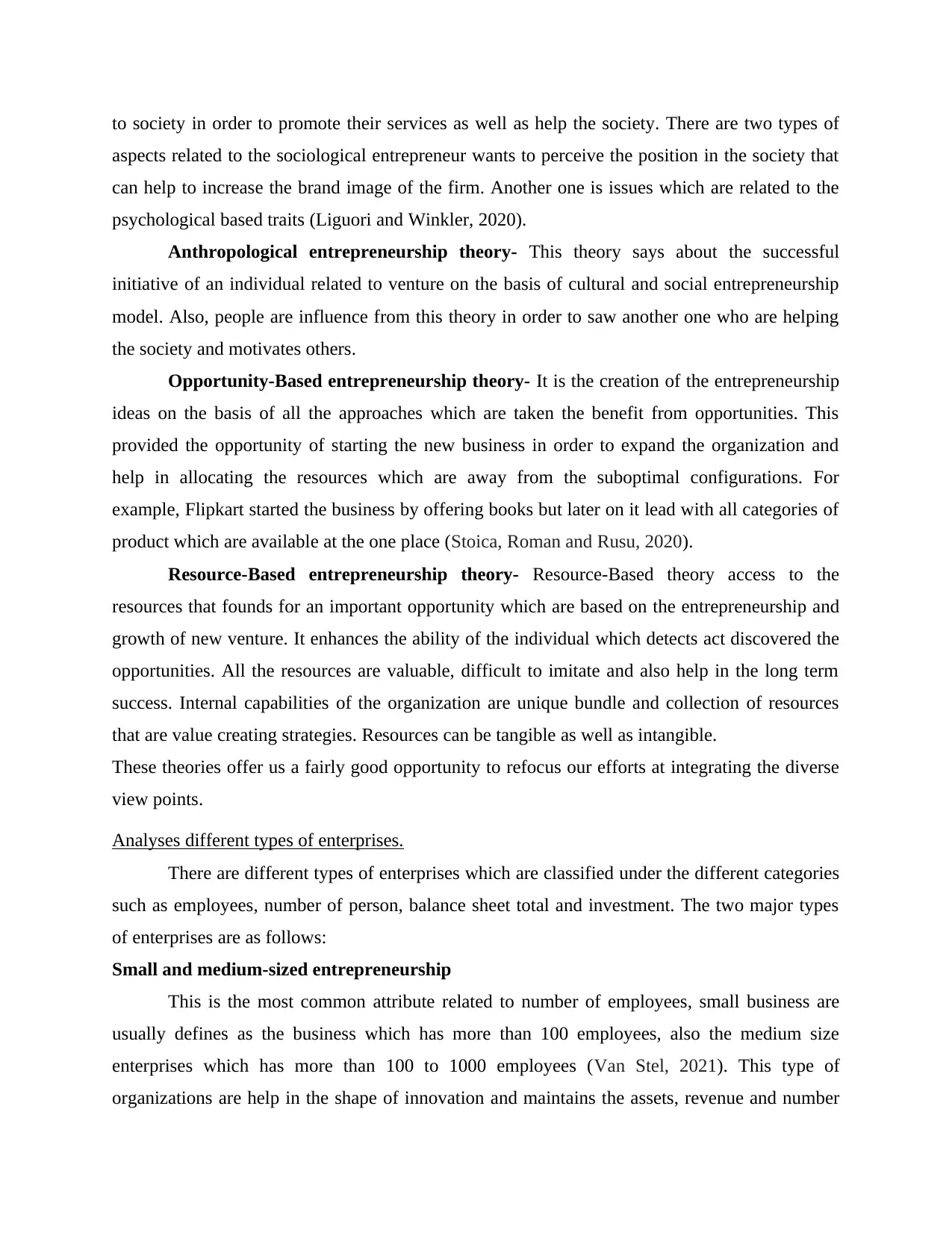
to society in order to promote their services as well as help the society. There are two types of
aspects related to the sociological entrepreneur wants to perceive the position in the society that
can help to increase the brand image of the firm. Another one is issues which are related to the
psychological based traits (Liguori and Winkler, 2020).
Anthropological entrepreneurship theory- This theory says about the successful
initiative of an individual related to venture on the basis of cultural and social entrepreneurship
model. Also, people are influence from this theory in order to saw another one who are helping
the society and motivates others.
Opportunity-Based entrepreneurship theory- It is the creation of the entrepreneurship
ideas on the basis of all the approaches which are taken the benefit from opportunities. This
provided the opportunity of starting the new business in order to expand the organization and
help in allocating the resources which are away from the suboptimal configurations. For
example, Flipkart started the business by offering books but later on it lead with all categories of
product which are available at the one place (Stoica, Roman and Rusu, 2020).
Resource-Based entrepreneurship theory- Resource-Based theory access to the
resources that founds for an important opportunity which are based on the entrepreneurship and
growth of new venture. It enhances the ability of the individual which detects act discovered the
opportunities. All the resources are valuable, difficult to imitate and also help in the long term
success. Internal capabilities of the organization are unique bundle and collection of resources
that are value creating strategies. Resources can be tangible as well as intangible.
These theories offer us a fairly good opportunity to refocus our efforts at integrating the diverse
view points.
Analyses different types of enterprises.
There are different types of enterprises which are classified under the different categories
such as employees, number of person, balance sheet total and investment. The two major types
of enterprises are as follows:
Small and medium-sized entrepreneurship
This is the most common attribute related to number of employees, small business are
usually defines as the business which has more than 100 employees, also the medium size
enterprises which has more than 100 to 1000 employees (Van Stel, 2021). This type of
organizations are help in the shape of innovation and maintains the assets, revenue and number
aspects related to the sociological entrepreneur wants to perceive the position in the society that
can help to increase the brand image of the firm. Another one is issues which are related to the
psychological based traits (Liguori and Winkler, 2020).
Anthropological entrepreneurship theory- This theory says about the successful
initiative of an individual related to venture on the basis of cultural and social entrepreneurship
model. Also, people are influence from this theory in order to saw another one who are helping
the society and motivates others.
Opportunity-Based entrepreneurship theory- It is the creation of the entrepreneurship
ideas on the basis of all the approaches which are taken the benefit from opportunities. This
provided the opportunity of starting the new business in order to expand the organization and
help in allocating the resources which are away from the suboptimal configurations. For
example, Flipkart started the business by offering books but later on it lead with all categories of
product which are available at the one place (Stoica, Roman and Rusu, 2020).
Resource-Based entrepreneurship theory- Resource-Based theory access to the
resources that founds for an important opportunity which are based on the entrepreneurship and
growth of new venture. It enhances the ability of the individual which detects act discovered the
opportunities. All the resources are valuable, difficult to imitate and also help in the long term
success. Internal capabilities of the organization are unique bundle and collection of resources
that are value creating strategies. Resources can be tangible as well as intangible.
These theories offer us a fairly good opportunity to refocus our efforts at integrating the diverse
view points.
Analyses different types of enterprises.
There are different types of enterprises which are classified under the different categories
such as employees, number of person, balance sheet total and investment. The two major types
of enterprises are as follows:
Small and medium-sized entrepreneurship
This is the most common attribute related to number of employees, small business are
usually defines as the business which has more than 100 employees, also the medium size
enterprises which has more than 100 to 1000 employees (Van Stel, 2021). This type of
organizations are help in the shape of innovation and maintains the assets, revenue and number
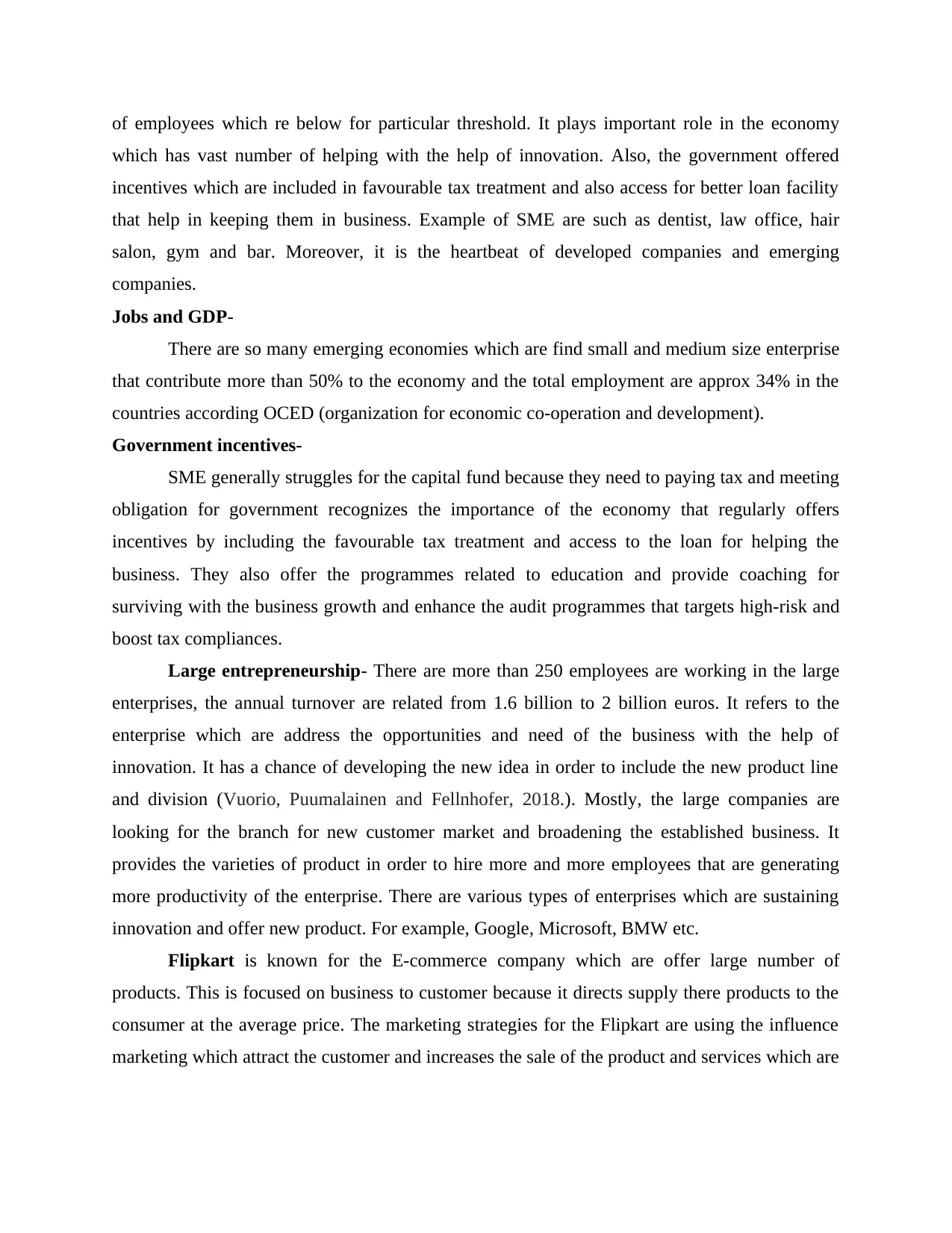
of employees which re below for particular threshold. It plays important role in the economy
which has vast number of helping with the help of innovation. Also, the government offered
incentives which are included in favourable tax treatment and also access for better loan facility
that help in keeping them in business. Example of SME are such as dentist, law office, hair
salon, gym and bar. Moreover, it is the heartbeat of developed companies and emerging
companies.
Jobs and GDP-
There are so many emerging economies which are find small and medium size enterprise
that contribute more than 50% to the economy and the total employment are approx 34% in the
countries according OCED (organization for economic co-operation and development).
Government incentives-
SME generally struggles for the capital fund because they need to paying tax and meeting
obligation for government recognizes the importance of the economy that regularly offers
incentives by including the favourable tax treatment and access to the loan for helping the
business. They also offer the programmes related to education and provide coaching for
surviving with the business growth and enhance the audit programmes that targets high-risk and
boost tax compliances.
Large entrepreneurship- There are more than 250 employees are working in the large
enterprises, the annual turnover are related from 1.6 billion to 2 billion euros. It refers to the
enterprise which are address the opportunities and need of the business with the help of
innovation. It has a chance of developing the new idea in order to include the new product line
and division (Vuorio, Puumalainen and Fellnhofer, 2018.). Mostly, the large companies are
looking for the branch for new customer market and broadening the established business. It
provides the varieties of product in order to hire more and more employees that are generating
more productivity of the enterprise. There are various types of enterprises which are sustaining
innovation and offer new product. For example, Google, Microsoft, BMW etc.
Flipkart is known for the E-commerce company which are offer large number of
products. This is focused on business to customer because it directs supply there products to the
consumer at the average price. The marketing strategies for the Flipkart are using the influence
marketing which attract the customer and increases the sale of the product and services which are
which has vast number of helping with the help of innovation. Also, the government offered
incentives which are included in favourable tax treatment and also access for better loan facility
that help in keeping them in business. Example of SME are such as dentist, law office, hair
salon, gym and bar. Moreover, it is the heartbeat of developed companies and emerging
companies.
Jobs and GDP-
There are so many emerging economies which are find small and medium size enterprise
that contribute more than 50% to the economy and the total employment are approx 34% in the
countries according OCED (organization for economic co-operation and development).
Government incentives-
SME generally struggles for the capital fund because they need to paying tax and meeting
obligation for government recognizes the importance of the economy that regularly offers
incentives by including the favourable tax treatment and access to the loan for helping the
business. They also offer the programmes related to education and provide coaching for
surviving with the business growth and enhance the audit programmes that targets high-risk and
boost tax compliances.
Large entrepreneurship- There are more than 250 employees are working in the large
enterprises, the annual turnover are related from 1.6 billion to 2 billion euros. It refers to the
enterprise which are address the opportunities and need of the business with the help of
innovation. It has a chance of developing the new idea in order to include the new product line
and division (Vuorio, Puumalainen and Fellnhofer, 2018.). Mostly, the large companies are
looking for the branch for new customer market and broadening the established business. It
provides the varieties of product in order to hire more and more employees that are generating
more productivity of the enterprise. There are various types of enterprises which are sustaining
innovation and offer new product. For example, Google, Microsoft, BMW etc.
Flipkart is known for the E-commerce company which are offer large number of
products. This is focused on business to customer because it directs supply there products to the
consumer at the average price. The marketing strategies for the Flipkart are using the influence
marketing which attract the customer and increases the sale of the product and services which are
⊘ This is a preview!⊘
Do you want full access?
Subscribe today to unlock all pages.

Trusted by 1+ million students worldwide
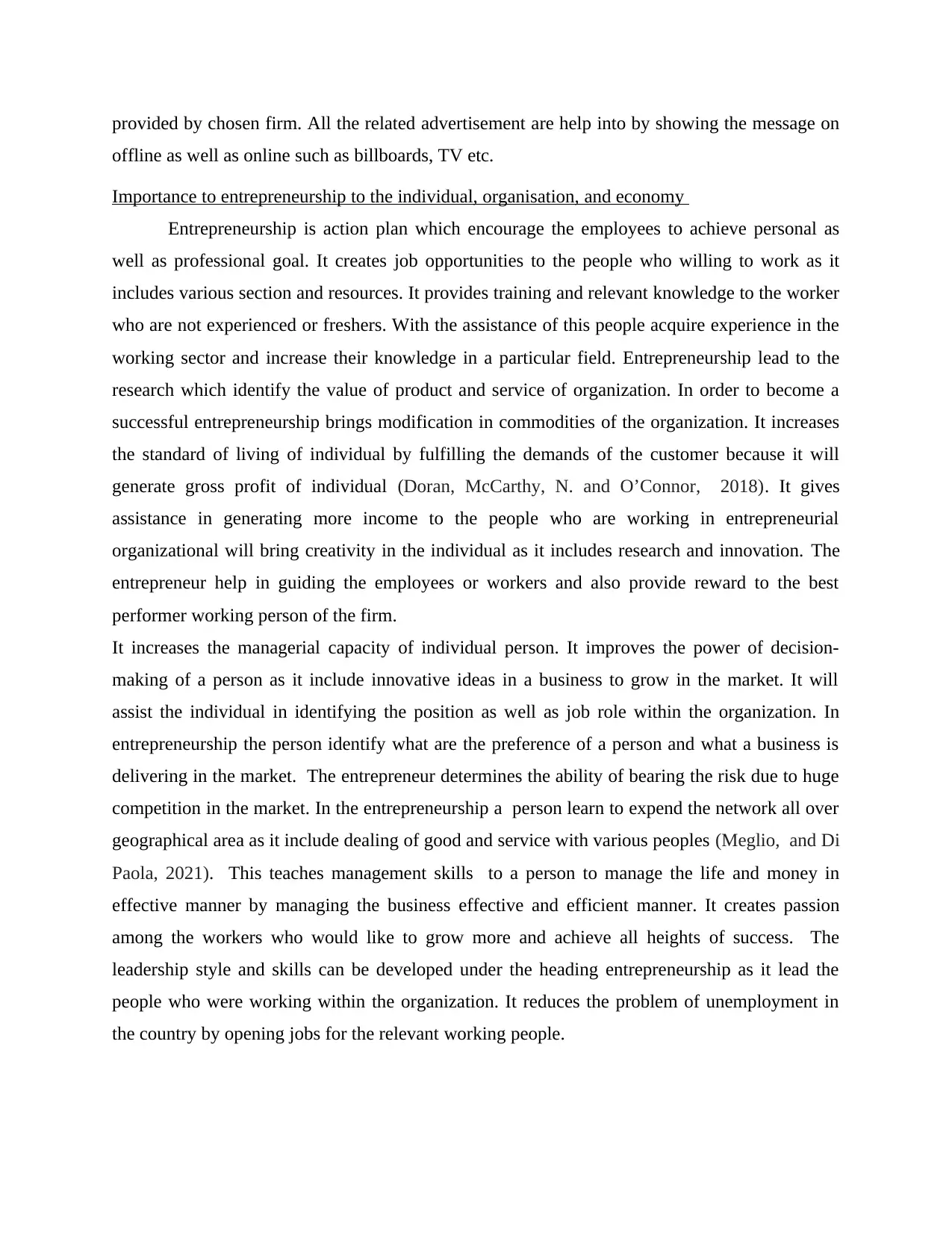
provided by chosen firm. All the related advertisement are help into by showing the message on
offline as well as online such as billboards, TV etc.
Importance to entrepreneurship to the individual, organisation, and economy
Entrepreneurship is action plan which encourage the employees to achieve personal as
well as professional goal. It creates job opportunities to the people who willing to work as it
includes various section and resources. It provides training and relevant knowledge to the worker
who are not experienced or freshers. With the assistance of this people acquire experience in the
working sector and increase their knowledge in a particular field. Entrepreneurship lead to the
research which identify the value of product and service of organization. In order to become a
successful entrepreneurship brings modification in commodities of the organization. It increases
the standard of living of individual by fulfilling the demands of the customer because it will
generate gross profit of individual (Doran, McCarthy, N. and O’Connor, 2018). It gives
assistance in generating more income to the people who are working in entrepreneurial
organizational will bring creativity in the individual as it includes research and innovation. The
entrepreneur help in guiding the employees or workers and also provide reward to the best
performer working person of the firm.
It increases the managerial capacity of individual person. It improves the power of decision-
making of a person as it include innovative ideas in a business to grow in the market. It will
assist the individual in identifying the position as well as job role within the organization. In
entrepreneurship the person identify what are the preference of a person and what a business is
delivering in the market. The entrepreneur determines the ability of bearing the risk due to huge
competition in the market. In the entrepreneurship a person learn to expend the network all over
geographical area as it include dealing of good and service with various peoples (Meglio, and Di
Paola, 2021). This teaches management skills to a person to manage the life and money in
effective manner by managing the business effective and efficient manner. It creates passion
among the workers who would like to grow more and achieve all heights of success. The
leadership style and skills can be developed under the heading entrepreneurship as it lead the
people who were working within the organization. It reduces the problem of unemployment in
the country by opening jobs for the relevant working people.
offline as well as online such as billboards, TV etc.
Importance to entrepreneurship to the individual, organisation, and economy
Entrepreneurship is action plan which encourage the employees to achieve personal as
well as professional goal. It creates job opportunities to the people who willing to work as it
includes various section and resources. It provides training and relevant knowledge to the worker
who are not experienced or freshers. With the assistance of this people acquire experience in the
working sector and increase their knowledge in a particular field. Entrepreneurship lead to the
research which identify the value of product and service of organization. In order to become a
successful entrepreneurship brings modification in commodities of the organization. It increases
the standard of living of individual by fulfilling the demands of the customer because it will
generate gross profit of individual (Doran, McCarthy, N. and O’Connor, 2018). It gives
assistance in generating more income to the people who are working in entrepreneurial
organizational will bring creativity in the individual as it includes research and innovation. The
entrepreneur help in guiding the employees or workers and also provide reward to the best
performer working person of the firm.
It increases the managerial capacity of individual person. It improves the power of decision-
making of a person as it include innovative ideas in a business to grow in the market. It will
assist the individual in identifying the position as well as job role within the organization. In
entrepreneurship the person identify what are the preference of a person and what a business is
delivering in the market. The entrepreneur determines the ability of bearing the risk due to huge
competition in the market. In the entrepreneurship a person learn to expend the network all over
geographical area as it include dealing of good and service with various peoples (Meglio, and Di
Paola, 2021). This teaches management skills to a person to manage the life and money in
effective manner by managing the business effective and efficient manner. It creates passion
among the workers who would like to grow more and achieve all heights of success. The
leadership style and skills can be developed under the heading entrepreneurship as it lead the
people who were working within the organization. It reduces the problem of unemployment in
the country by opening jobs for the relevant working people.
Paraphrase This Document
Need a fresh take? Get an instant paraphrase of this document with our AI Paraphraser
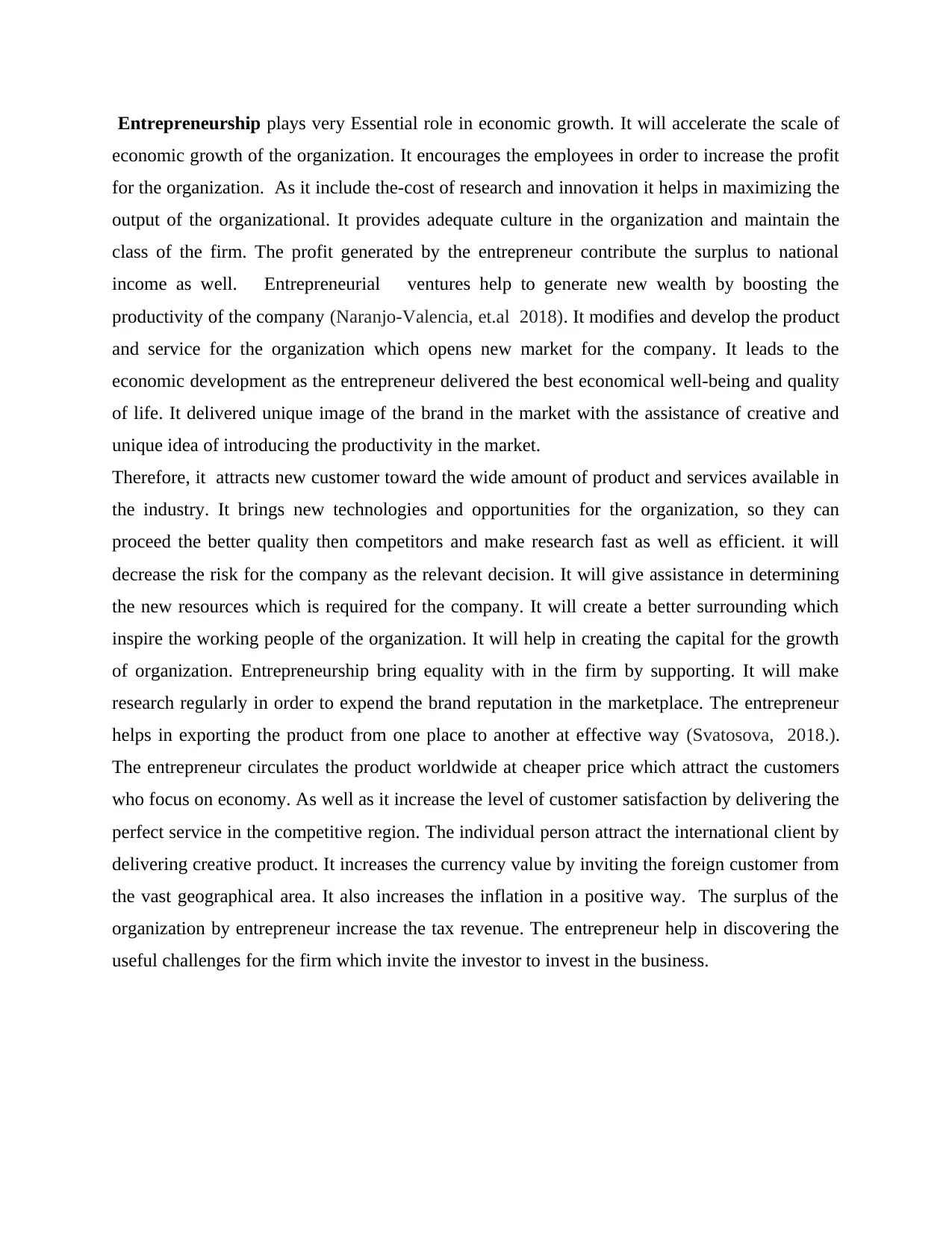
Entrepreneurship plays very Essential role in economic growth. It will accelerate the scale of
economic growth of the organization. It encourages the employees in order to increase the profit
for the organization. As it include the-cost of research and innovation it helps in maximizing the
output of the organizational. It provides adequate culture in the organization and maintain the
class of the firm. The profit generated by the entrepreneur contribute the surplus to national
income as well. Entrepreneurial ventures help to generate new wealth by boosting the
productivity of the company (Naranjo-Valencia, et.al 2018). It modifies and develop the product
and service for the organization which opens new market for the company. It leads to the
economic development as the entrepreneur delivered the best economical well-being and quality
of life. It delivered unique image of the brand in the market with the assistance of creative and
unique idea of introducing the productivity in the market.
Therefore, it attracts new customer toward the wide amount of product and services available in
the industry. It brings new technologies and opportunities for the organization, so they can
proceed the better quality then competitors and make research fast as well as efficient. it will
decrease the risk for the company as the relevant decision. It will give assistance in determining
the new resources which is required for the company. It will create a better surrounding which
inspire the working people of the organization. It will help in creating the capital for the growth
of organization. Entrepreneurship bring equality with in the firm by supporting. It will make
research regularly in order to expend the brand reputation in the marketplace. The entrepreneur
helps in exporting the product from one place to another at effective way (Svatosova, 2018.).
The entrepreneur circulates the product worldwide at cheaper price which attract the customers
who focus on economy. As well as it increase the level of customer satisfaction by delivering the
perfect service in the competitive region. The individual person attract the international client by
delivering creative product. It increases the currency value by inviting the foreign customer from
the vast geographical area. It also increases the inflation in a positive way. The surplus of the
organization by entrepreneur increase the tax revenue. The entrepreneur help in discovering the
useful challenges for the firm which invite the investor to invest in the business.
economic growth of the organization. It encourages the employees in order to increase the profit
for the organization. As it include the-cost of research and innovation it helps in maximizing the
output of the organizational. It provides adequate culture in the organization and maintain the
class of the firm. The profit generated by the entrepreneur contribute the surplus to national
income as well. Entrepreneurial ventures help to generate new wealth by boosting the
productivity of the company (Naranjo-Valencia, et.al 2018). It modifies and develop the product
and service for the organization which opens new market for the company. It leads to the
economic development as the entrepreneur delivered the best economical well-being and quality
of life. It delivered unique image of the brand in the market with the assistance of creative and
unique idea of introducing the productivity in the market.
Therefore, it attracts new customer toward the wide amount of product and services available in
the industry. It brings new technologies and opportunities for the organization, so they can
proceed the better quality then competitors and make research fast as well as efficient. it will
decrease the risk for the company as the relevant decision. It will give assistance in determining
the new resources which is required for the company. It will create a better surrounding which
inspire the working people of the organization. It will help in creating the capital for the growth
of organization. Entrepreneurship bring equality with in the firm by supporting. It will make
research regularly in order to expend the brand reputation in the marketplace. The entrepreneur
helps in exporting the product from one place to another at effective way (Svatosova, 2018.).
The entrepreneur circulates the product worldwide at cheaper price which attract the customers
who focus on economy. As well as it increase the level of customer satisfaction by delivering the
perfect service in the competitive region. The individual person attract the international client by
delivering creative product. It increases the currency value by inviting the foreign customer from
the vast geographical area. It also increases the inflation in a positive way. The surplus of the
organization by entrepreneur increase the tax revenue. The entrepreneur help in discovering the
useful challenges for the firm which invite the investor to invest in the business.
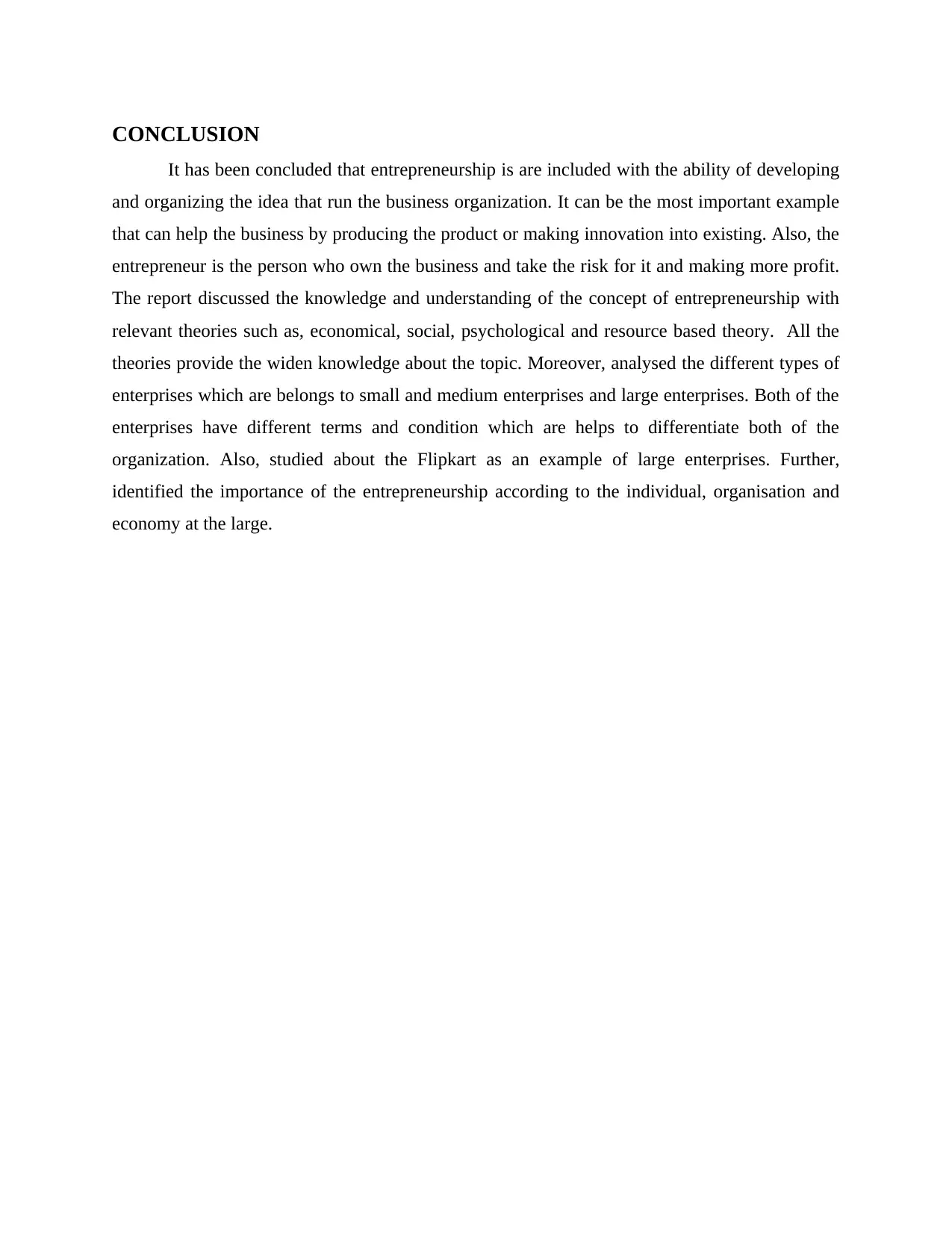
CONCLUSION
It has been concluded that entrepreneurship is are included with the ability of developing
and organizing the idea that run the business organization. It can be the most important example
that can help the business by producing the product or making innovation into existing. Also, the
entrepreneur is the person who own the business and take the risk for it and making more profit.
The report discussed the knowledge and understanding of the concept of entrepreneurship with
relevant theories such as, economical, social, psychological and resource based theory. All the
theories provide the widen knowledge about the topic. Moreover, analysed the different types of
enterprises which are belongs to small and medium enterprises and large enterprises. Both of the
enterprises have different terms and condition which are helps to differentiate both of the
organization. Also, studied about the Flipkart as an example of large enterprises. Further,
identified the importance of the entrepreneurship according to the individual, organisation and
economy at the large.
It has been concluded that entrepreneurship is are included with the ability of developing
and organizing the idea that run the business organization. It can be the most important example
that can help the business by producing the product or making innovation into existing. Also, the
entrepreneur is the person who own the business and take the risk for it and making more profit.
The report discussed the knowledge and understanding of the concept of entrepreneurship with
relevant theories such as, economical, social, psychological and resource based theory. All the
theories provide the widen knowledge about the topic. Moreover, analysed the different types of
enterprises which are belongs to small and medium enterprises and large enterprises. Both of the
enterprises have different terms and condition which are helps to differentiate both of the
organization. Also, studied about the Flipkart as an example of large enterprises. Further,
identified the importance of the entrepreneurship according to the individual, organisation and
economy at the large.
⊘ This is a preview!⊘
Do you want full access?
Subscribe today to unlock all pages.

Trusted by 1+ million students worldwide
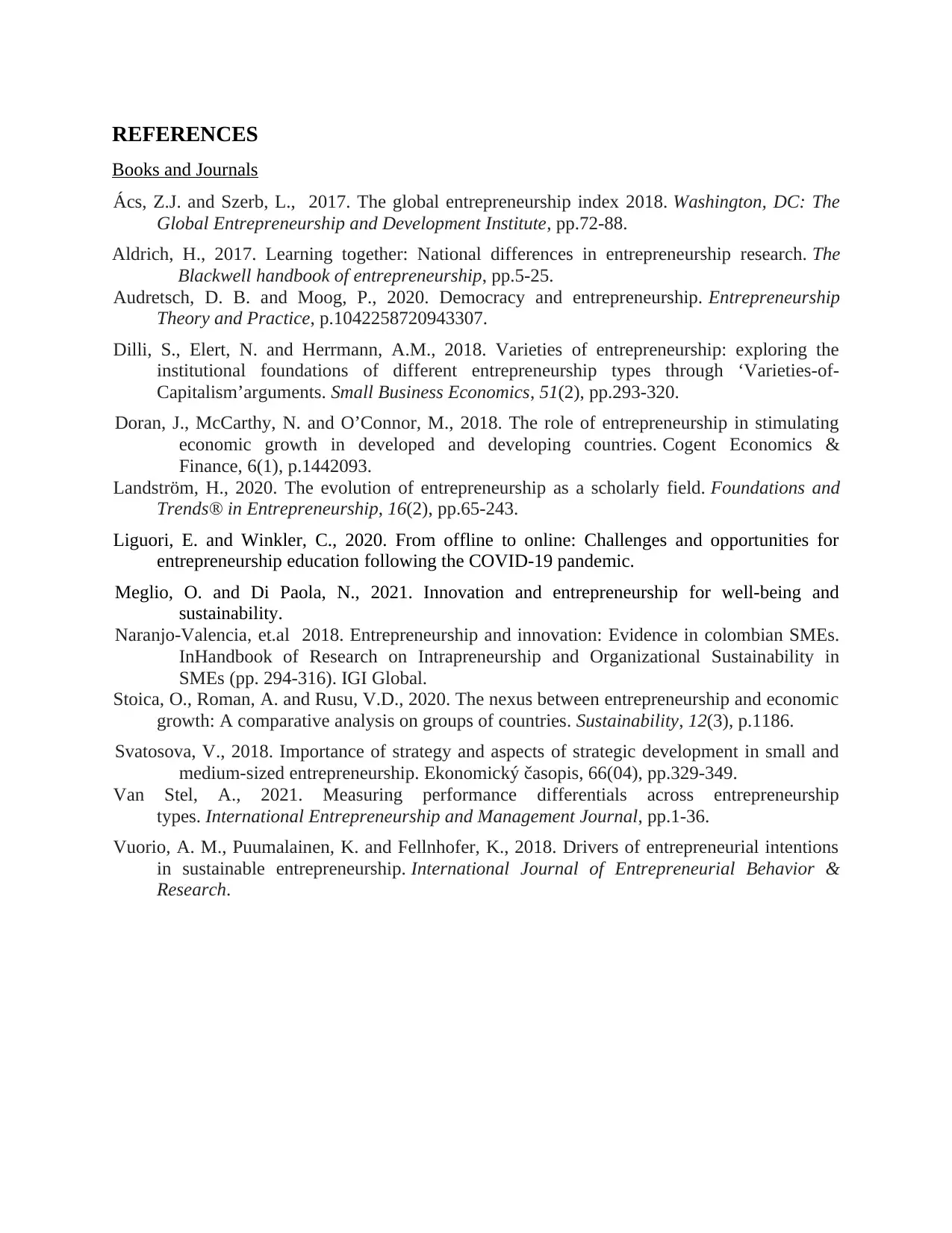
REFERENCES
Books and Journals
Ács, Z.J. and Szerb, L., 2017. The global entrepreneurship index 2018. Washington, DC: The
Global Entrepreneurship and Development Institute, pp.72-88.
Aldrich, H., 2017. Learning together: National differences in entrepreneurship research. The
Blackwell handbook of entrepreneurship, pp.5-25.
Audretsch, D. B. and Moog, P., 2020. Democracy and entrepreneurship. Entrepreneurship
Theory and Practice, p.1042258720943307.
Dilli, S., Elert, N. and Herrmann, A.M., 2018. Varieties of entrepreneurship: exploring the
institutional foundations of different entrepreneurship types through ‘Varieties-of-
Capitalism’arguments. Small Business Economics, 51(2), pp.293-320.
Doran, J., McCarthy, N. and O’Connor, M., 2018. The role of entrepreneurship in stimulating
economic growth in developed and developing countries. Cogent Economics &
Finance, 6(1), p.1442093.
Landström, H., 2020. The evolution of entrepreneurship as a scholarly field. Foundations and
Trends® in Entrepreneurship, 16(2), pp.65-243.
Liguori, E. and Winkler, C., 2020. From offline to online: Challenges and opportunities for
entrepreneurship education following the COVID-19 pandemic.
Meglio, O. and Di Paola, N., 2021. Innovation and entrepreneurship for well-being and
sustainability.
Naranjo-Valencia, et.al 2018. Entrepreneurship and innovation: Evidence in colombian SMEs.
InHandbook of Research on Intrapreneurship and Organizational Sustainability in
SMEs (pp. 294-316). IGI Global.
Stoica, O., Roman, A. and Rusu, V.D., 2020. The nexus between entrepreneurship and economic
growth: A comparative analysis on groups of countries. Sustainability, 12(3), p.1186.
Svatosova, V., 2018. Importance of strategy and aspects of strategic development in small and
medium-sized entrepreneurship. Ekonomický časopis, 66(04), pp.329-349.
Van Stel, A., 2021. Measuring performance differentials across entrepreneurship
types. International Entrepreneurship and Management Journal, pp.1-36.
Vuorio, A. M., Puumalainen, K. and Fellnhofer, K., 2018. Drivers of entrepreneurial intentions
in sustainable entrepreneurship. International Journal of Entrepreneurial Behavior &
Research.
Books and Journals
Ács, Z.J. and Szerb, L., 2017. The global entrepreneurship index 2018. Washington, DC: The
Global Entrepreneurship and Development Institute, pp.72-88.
Aldrich, H., 2017. Learning together: National differences in entrepreneurship research. The
Blackwell handbook of entrepreneurship, pp.5-25.
Audretsch, D. B. and Moog, P., 2020. Democracy and entrepreneurship. Entrepreneurship
Theory and Practice, p.1042258720943307.
Dilli, S., Elert, N. and Herrmann, A.M., 2018. Varieties of entrepreneurship: exploring the
institutional foundations of different entrepreneurship types through ‘Varieties-of-
Capitalism’arguments. Small Business Economics, 51(2), pp.293-320.
Doran, J., McCarthy, N. and O’Connor, M., 2018. The role of entrepreneurship in stimulating
economic growth in developed and developing countries. Cogent Economics &
Finance, 6(1), p.1442093.
Landström, H., 2020. The evolution of entrepreneurship as a scholarly field. Foundations and
Trends® in Entrepreneurship, 16(2), pp.65-243.
Liguori, E. and Winkler, C., 2020. From offline to online: Challenges and opportunities for
entrepreneurship education following the COVID-19 pandemic.
Meglio, O. and Di Paola, N., 2021. Innovation and entrepreneurship for well-being and
sustainability.
Naranjo-Valencia, et.al 2018. Entrepreneurship and innovation: Evidence in colombian SMEs.
InHandbook of Research on Intrapreneurship and Organizational Sustainability in
SMEs (pp. 294-316). IGI Global.
Stoica, O., Roman, A. and Rusu, V.D., 2020. The nexus between entrepreneurship and economic
growth: A comparative analysis on groups of countries. Sustainability, 12(3), p.1186.
Svatosova, V., 2018. Importance of strategy and aspects of strategic development in small and
medium-sized entrepreneurship. Ekonomický časopis, 66(04), pp.329-349.
Van Stel, A., 2021. Measuring performance differentials across entrepreneurship
types. International Entrepreneurship and Management Journal, pp.1-36.
Vuorio, A. M., Puumalainen, K. and Fellnhofer, K., 2018. Drivers of entrepreneurial intentions
in sustainable entrepreneurship. International Journal of Entrepreneurial Behavior &
Research.
1 out of 10
Related Documents
Your All-in-One AI-Powered Toolkit for Academic Success.
+13062052269
info@desklib.com
Available 24*7 on WhatsApp / Email
![[object Object]](/_next/static/media/star-bottom.7253800d.svg)
Unlock your academic potential
Copyright © 2020–2026 A2Z Services. All Rights Reserved. Developed and managed by ZUCOL.


